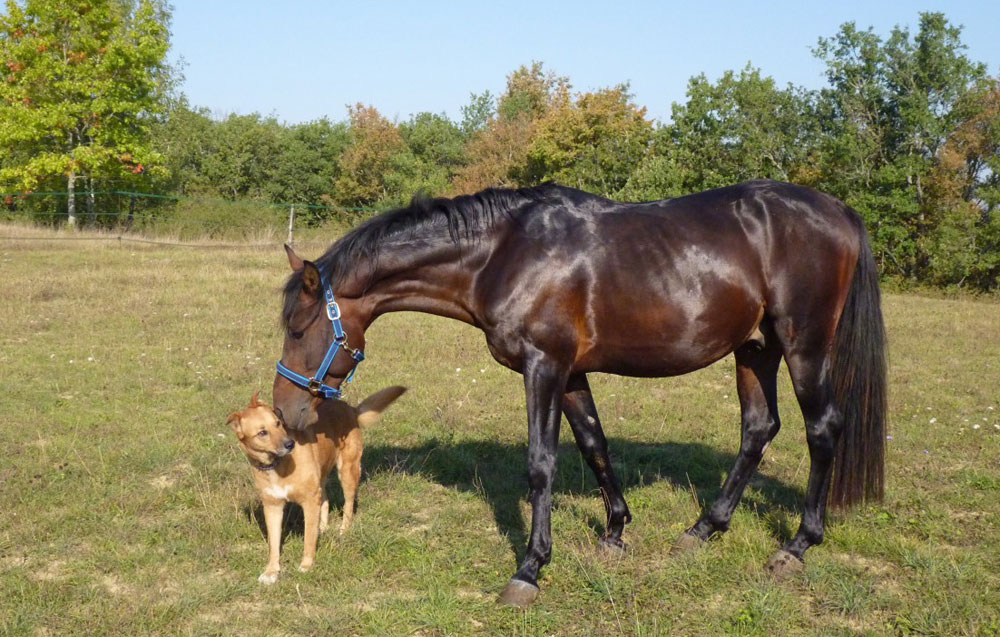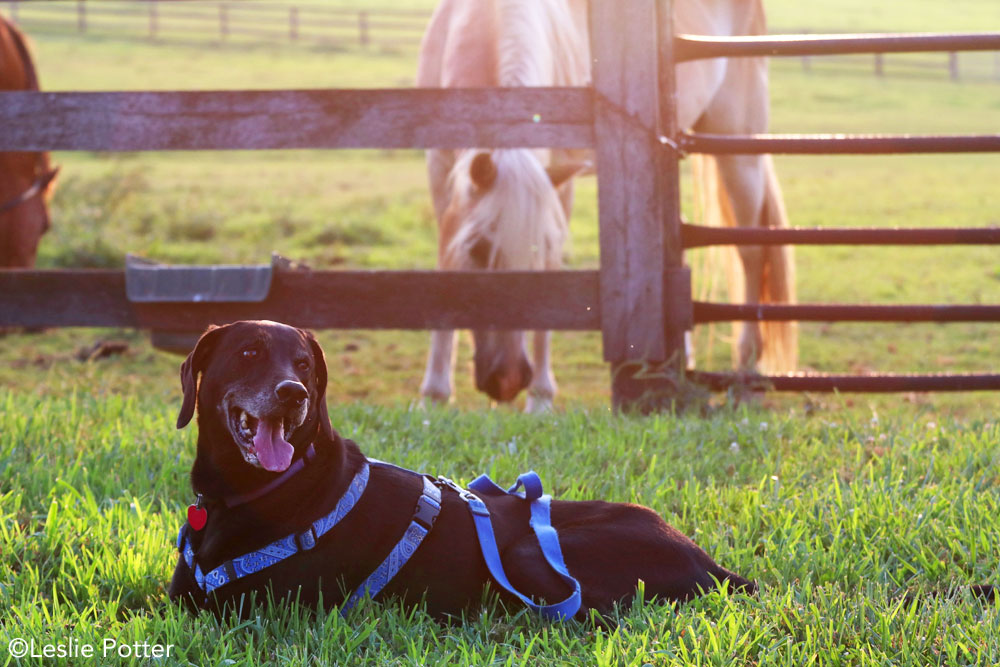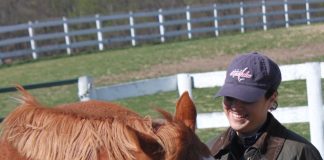If your four-legged friends have hooves and paws, chances are they’ll spend time together at the barn. But do you know the potential risks involved with bringing your dog and horse together at the barn? Set your horses and dogs up for success by understanding the potential safety concerns, taking steps to mitigate any hazards, and determining whether your dog is cut out for the barn life.

Dog, Horse and Rider Safety Concerns
It makes sense for your barn to cater to your horse’s needs more so than your pup’s. But, if your barn is not set up with your dog in mind, your dog, your horse or even you could end up injured.
The biggest concern is when the dog is not respecting the horse’s space, which can cause your horse to bolt, shy away or hurt the dog, explains Dr. Katherine Albro Houpt, VMD, Ph.D., DACVB, a semi-retired veterinarian with Cornell University and Orchard Park Veterinary Medical Center in Buffalo, New York.
Both visual and auditory stimuli, like your dog barking and running toward the horse, can result in your horse instinctively reacting to the situation, Dr. Houpt says.
This concern is not something to take lightly, says Irith Bloom, a certified professional dog trainer and owner of The Sophisticated Dog training company in Los Angeles, California.
“A dog chasing a horse puts both animals—as well as the rider on the horse—in a very dangerous situation,” Bloom says. “A spooked horse may bolt, throw the rider, or injure himself. Some horses will even attack when threatened. A horse can kill a dog with a well-aimed kick, or simply by trampling it.”
If there is any risk that a dog will start chasing a horse, Bloom recommends keeping the dog far away from your horse at all times, for both of their sakes.
So, how does one do that? Dr. Houpt suggests setting up an invisible fence at home so your dog cannot get to your horses. Or keep your dog on a leash or in a secure area. Training may help, too (more on that later). Bottom line: If you can’t control your dog, Dr. Houpt says it’s best not to bring him to the barn.
Potential Hazards Around the Barn
In addition to your horse, there are a number of items around the barn that could harm your dog.
If left unsupervised, your dog might eat some horse supplies, which may upset his stomach—or even worse, could be toxic if ingested.
“Horse medication could be toxic,” Dr. Houpt says. “If a 10-pound dog ate a 1,000-pound horse’s medication, it could certainly cause serious issues.”
Other items that your dog might sample include hoof trimmings, horse feed and manure, she adds.
There also is a possibility that your dog could run away or get hit by farm machinery, like a tractor, if left unattended at the barn. Farm machinery can be extremely unsafe and can severely cut or crush your dog, Dr. Houpt warns.
Because there are so many risks that come with having your dog unsupervised while on the loose, the smartest thing to do is to confine him in a safe space.
“You shouldn’t leave your dog unattended at the barn,” Dr. Houpt says. “If anything, you should leave him in a box stall to enclose him when you cannot supervise him.”
She suggests giving your dog a toy or chew to keep him occupied while confined.
“If you are going to confine your dog, I would leave him with something he really likes, like a KONG filled with cheese or something really good that will take him a long time to really finish,” she says.
Beyond preventative measures, there are also training techniques you can work on with your dog to help keep him safe.

Training Your Dog to Be Barn Ready
The best thing to do to get dogs ready for the barn is to properly train them for any situation that could occur. Here are some training commands Bloom recommends for barn dog safety:
Barn Dog Safety: Reliable Recall (aka coming when called)
“A reliable recall is useful on trail rides, so you can call the dog back to you,” Bloom explains. “It’s also useful in other contexts, since you may need to call the dog away from a horse or other animal.”
Start with your dog on a leash and say your dog’s name and the command “come.” Give your dog praise as he starts to move toward you. Provide treats as a reward upon arrival. Increase distance as your dog improves.
Barn Dog Safety: Waiting for Permission
You should also teach your dog to wait for permission before going through gates or entering paddocks and stalls, explains Bloom.
To teach your dog to stay, ask him to sit and then give him a treat when he listens. Repeat but delay the giving of the treat. Once your dog can hold a sit for at least 15 seconds, use the command “stay” or “wait.” Then, after the appropriate amount of time, say your release command (e.g. “OK” or “Go”) and toss treats so that your dog has to get up to retrieve them.
Barn Dog Safety: “Leave It” Cue
“A good ‘leave it’ is a great skill for any dog,” Bloom says. “When trained, it can be used to keep a dog out of a lot of trouble.”
You can use the “leave it” cue to keep a dog from ingesting things like horse poop, rolling in manure or chasing other farm animals, Bloom adds.
Hold a treat out in a closed hand off to the side. Wait for your dog to look away from the treat (or better yet, make eye contact with you). As soon as your dog looks at your face, click and reward with a treat from the other hand. Once your dog has gotten used to looking at you, not the treat, add the command “leave it” when you put your closed hand out with the treat inside. So, say your leave it cue, you put your arm out to the side, your dog looks at you, and you click and then reward with a treat from the other hand.
Trust Your Instincts and Know Your Dog
As much fun as it can be to hang out with dogs and horses at the same time, some dogs just aren’t cut out for the barn life.
“Dogs that have a strong prey drive aren’t always great around the barn,” Bloom warns. “While some of these dogs confine their predatory behavior to appropriate targets, such as rodents and coyotes, others will chase anything and everything, including horses.”
Another indicator that your dog may not be meant for the barn is if your dog gets anxious and barks a lot. This type of behavior can create problems around the barn, Bloom says.
If you’re planning to bring your dog to the barn for the first time to see how it goes, you must take the time to prepare your dog for the barn beforehand.
“Before bringing a dog to the barn for the first time, train a great recall and a strong leave it. And the first time you visit, keep your dog on leash, just in case,” Bloom stresses.
As long as you trust your instincts, know your dog, plan ahead and prepare the barn for everyone’s safety, there is a good chance that your dogs and horses could be at the barn together in peace and harmony.





